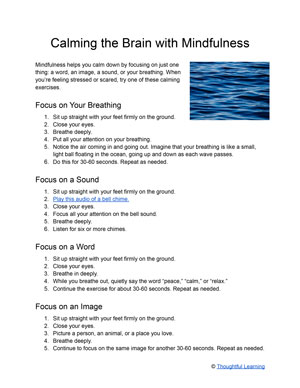
Living through a pandemic has placed an enormous mental-health burden on students. Stress and isolation have increased anxiety, depression, and suicidal thoughts among young people.
Even though students are slowly returning to in-person classes, the mental toll of the past year will likely linger for a long time, influencing learning and behavior. How, then, can you best support your students’ social and emotional well-being while also caring for your own?
To start, it is important to recognize what stress does to the brain. With that understanding, you can plan and respond in healthy ways.
How does stress impact a young person’s brain?
Stress triggers a number of brain processes that impact learning and behavior. When students feel scared or threatened, much of their processing and energy drops from the cortex, where thinking and decision-making take place, down to the limbic system, where emotions are produced.

In other words, stress hijacks the learning center of the brain. Stressed students, therefore, will struggle to concentrate, process information, and make good decisions.
Stress also activates a fight, flight, or freeze response. Under normal conditions, this response keeps you safe and healthy. But when stress and anxiety are prolonged—like during a pandemic—the brain structure responsible for this response (the amygdala) can grow and become more sensitive.
The result is as if a smoke alarm went off the moment you placed a tea kettle on stovetop. Every small stressor becomes a big threat.
So, you can imagine the potential consequences on students’ behavior.
What can you do about it?
Now for some good news about young brains: While growing brains are vulnerable to stress, their plasticity also allows for healing. With proper social and emotional support, brains can actually change and heal.
That’s why it’s so crucial to develop a nurturing classroom environment where students feel safe and emotionally cared for.
While you can’t resolve all the stressors of daily life, you can build and improve your students’ mental health with consistent, daily SEL support. Today’s featured download teaches one approach.
Featured Activity: Calming the Brain with Mindfulness
Mindfulness techniques can calm the brain and body of stressed students (and educators). You can teach and practice each technique in just 10–15 minutes.
Download the PDF or copy the Google Doc.
Teaching Support
Consider this support as you practice mindfulness.
Level
K–12
Learning Objectives
By performing mindfulness, students will . . .
- Calm their minds and bodies.
- Direct their attention away from stressful thoughts.
- Accept emotions without judgment and let them go.
- Improve their focus and self-control.
- Prepare their minds for learning.
Teaching Tips
- Consider setting aside a specific time each day for mindfulness.
- Practice different mindfulness techniques as a class.
- Be alert for students who seem stressed or agitated. When you notice someone struggling, encourage mindfulness. “Are you feeling overwhelmed? Try concentrating on your breathing for the next minute. If you would like, you can go somewhere quiet.”
- Perform a quick class mindfulness session prior to big tests.
- Encourage students whose minds wander to gently redirect their thoughts to the mindfulness routine.
- Stick with it. Mindfulness improves the more you do it.
